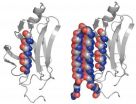(Press-News.org) A study of juvenile rat brain cells suggests that the effects of a commonly used anesthetic drug on the connections between brain cells are temporary.
The study, published in this week's issue of the journal PLOS ONE, was conducted by biologists at the University of California, San Diego and Weill Cornell Medical College in New York in response to concerns, arising from multiple studies on humans over the past decade, that exposing children to general anesthetics may increase their susceptibility to long-term cognitive and behavioral deficits, such as learning disabilities.
An estimated six million children, including 1.5 million infants, undergo surgery in the United States requiring general anesthesia each year and a least two large-scale clinical studies are now underway to determine the potential risks to children and adults.
"There is concern now about cognitive dysfunction from surgery and anesthesia—how much these effects are either permanent or slowly reversible is very controversial," said Hugh Hemmings, Jr., chair of anesthesiology at Weill Cornell and the study's other senior author. "It has been suggested recently that some of the effects of anesthesia may be more lasting than previously thought. It is not clear whether the residual effects after an operation are due to the surgery itself, or the hospitalization and attendant trauma, medications and stress—or a combination of these issues."
The team of biologists examined one of the most commonly used general anesthetics, a derivative of ether called "isoflurane" used to maintain anesthesia during surgery.
"Previous studies in cultured neurons and in the intact brains of rodents provided evidence suggesting that exposure to anesthetics might render neurons more susceptible to cell death through a process called 'apoptosis'," said Halpain. "While overt cell death could certainly be one way to explain any long-lasting neurocognitive consequences of general anesthesia, we hypothesized that there could be other cellular mechanisms that disrupt neural circuits without inducing cell death per se."
One such mechanism, she added, is known as "synaptotoxicity." In this mechanism of neural-circuit disruption, the "synapses," or junctions between neurons, become weakened or shrink away due to some factor that injures the neurons locally along their axons (the long processes of neurons that transmit signals) and dendrites (the threadlike extensions of neurons that receive nerve signals) without inducing the neurons themselves to die.
In the experiments at UC San Diego headed by Jimcy Platholi, a postdoctoral researcher in Halpain's lab who is now at Weill Cornell, the scientists used neurons from embryonic rats taken from the hippocampus, a part of the mammalian forebrain essential for encoding newly acquired memories and ensuring that short-term memories are converted into long-term memories. The researchers cultured these brain cells in a laboratory dish for three weeks, allowing the neurons time to mature and to develop a dense network of synaptic connections and "dendritic spines"—specialized structures that protrude from the dendrites and are essential mediators of activity throughout neural networks.
"Evidence from animal studies indicates that new dendritic spines emerge and existing spines expand in size during learning and memory," explained Halpain. "Therefore, the overall numbers and size of dendritic spines can profoundly impact the strength of neural networks. Since neural network activity underlies all brain function, changes in dendritic spine number and shape can influence cognition and behavior."
Using neurons in culture, rather than intact animal brains, allowed the biologists to take images of the synapses at high spatial resolution using techniques called fluorescence light microscopy and confocal imaging. They also used time-lapse microscopy to observe structural changes in individual dendritic spines during exposure to isoflurane. Karl Herold, a research associate in the Hemmings laboratory and a co-author of the study, performed some of the image analysis.
"Imaging of human brain synapses at this level of detail is impossible with today's technology and it remains very challenging even in laboratory rodents," said Halpain. "It was important that we performed our study using rodent neurons in a culture dish, so that we could really drill down into the subcellular and molecular details of how anesthetics work."
The researchers wondered whether brief exposure to isoflurane would alter the numbers and size of dendritic spines, so they applied the anesthetic to the cultured rat cells at concentrations and durations (up to 60 minutes) that are frequently used during surgery.
"We observed detectable decreases in dendritic spine numbers and shape within as little as 10 minutes," said Halpain. "However this spine loss and shrinkage was reversible after the anesthetic was washed out of the culture."
"Our study was reassuring in the sense that the effects are not irreversible and this fits in with known clinical effects," said Hemmings. "For the most part, we find that the effects are reversible."
"We clearly see an effect—a very marked effect on the dendritic spines—from use of this drug that was reversible, suggesting that it is not a toxic effect, but something more relevant to the pharmacological actions of the drug," he added. "Connecting what we found to the cognitive effects of isoflurane will require much more detailed analysis."
The team plans to follow up its study with future experiments to probe the molecular mechanisms and long-lasting consequences of isoflurane's effects on neuron synapses and examine other commonly-used anesthetics for surgery.
INFORMATION:
A copy of the paper can be accessed at http://dx.plos.org/10.1371/journal.pone.0102978 The study was supported by grants from the National Institutes of Health (MH087823 and GM58055).
Study suggests disruptive effects of anesthesia on brain cell connections are temporary
2014-07-28
ELSE PRESS RELEASES FROM THIS DATE:
UTSW cancer researchers identify irreversible inhibitor for KRAS gene mutation
2014-07-28
DALLAS – July 28, 2014 – UT Southwestern Medical Center cancer researchers have found a molecule that selectively and irreversibly interferes with the activity of a mutated cancer gene common in 30 percent of tumors.
The molecule, SML-8-73-1 (SML), interferes with the KRAS gene, or Kirsten rat sarcoma viral oncogene homolog. The gene produces proteins called K-Ras that influence when cells divide. Mutations in K-Ras can result in normal cells dividing uncontrollably and turning cancerous. These mutations are particularly found in cancers of the lung, pancreas, and colon. ...
Stress-tolerant tomato relative sequenced
2014-07-28
The genome of Solanum pennellii, a wild relative of the domestic tomato, has been published by an international group of researchers including the labs headed by Professors Neelima Sinha and Julin Maloof at the UC Davis Department of Plant Biology. The new genome information may help breeders produce tastier, more stress-tolerant tomatoes.
The work, published July 27 in the journal Nature Genetics, was lead by Björn Usadel and colleagues at Aachen University in Germany. The UC Davis labs carried out work on the transcriptome of S. pennellii — the RNA molecules that are ...
Researchers discover cool-burning flames in space, could lead to better engines on earth
2014-07-28
A team of international researchers has discovered a new type of cool burning flames that could lead to cleaner, more efficient engines for cars. The discovery was made during a series of experiments on the International Space Station by a team led by Forman Williams, a professor of mechanical and aerospace engineering at the University of California, San Diego. Researchers detailed their findings recently in the journal Microgravity Science and Technology.
"We observed something that we didn't think could exist," Williams said.
A better understanding of the cool flames' ...
HIV research findings made possible by a test developed at CU School of Pharmacy
2014-07-28
HIV research findings made possible by a test developed at University of Colorado Skaggs School of Pharmacy and Pharmaceutical Sciences (CU School of Pharmacy)
AURORA, Colo (July 28, 2014) An influential new test, discovered and developed in the Colorado Antiviral Pharmacology Laboratory at the CU School of Pharmacy, helps monitor the effectiveness of the HIV prevention drug called Truvada (a combination of tenofovir/emtricitabine), which is taken once daily to prevent HIV infection.
A study presented during the AIDS 2014 Conference and published in Lancet Infectious ...
NASA sees Tropical Storm Hernan near Mexico's Baja California
2014-07-28
Tropical Storm Hernan developed over this past weekend and reached hurricane strength before vertical wind shear kicked in and kicked the storm down. NASA's Terra satellite passed over Hernan when it was developing as a tropical depression near Baja California, Mexico.
Tropical Storm Hernan was born on Saturday, July 26 at 5 a.m. EDT as Tropical Depression 8-E. By 5 p.m. EDT it strengthened into Tropical Storm Hernan. At 11 a.m. EDT on Sunday, July 27, Hernan's maximum sustained winds were already up to 70 mph, just four miles per hour shy of hurricane status. As Hernan ...
NOAA: 'Nuisance flooding' an increasing problem as coastal sea levels rise
2014-07-28
Eight of the top 10 U.S. cities that have seen an increase in so-called "nuisance flooding"--which causes such public inconveniences as frequent road closures, overwhelmed storm drains and compromised infrastructure--are on the East Coast, according to a new NOAA technical report.
This nuisance flooding, caused by rising sea levels, has increased on all three U.S. coasts, between 300 and 925 percent since the 1960s.
The report, Sea Level Rise and Nuisance Flood Frequency Changes around the United States, also finds Annapolis and Baltimore, Maryland, lead the list with ...
Fist-bumping beats germ-spreading handshake, study reports
2014-07-28
Washington, DC, July 28, 2014 – "Fist bumping" transmits significantly fewer bacteria than either handshaking or high-fiving, while still addressing the cultural expectation of hand-to-hand contact between patients and clinicians, according to a study published in the August issue of the American Journal of Infection Control, the official publication of the Association for Professionals in Infection Control and Epidemiology (APIC).
In this study from the Institute of Biological, Environmental, and Rural Sciences at Aberystwyth University in the United Kingdom, researchers ...
New pill regimens published in The Lancet cure hardest-to-treat hepatitis C patients
2014-07-28
SAN ANTONIO (July 28, 2014) -- Researchers from The University of Texas Health Science Center at San Antonio, the Texas Liver Institute and other institutions have identified a combination of pills that cures 9 of 10 hepatitis C patients.
The combination of the drugs sofosbuvir and simeprevir, with or without ribavirin, cured 93 percent of patients in 12 weeks, and was well tolerated by patients, according to the study published today in The Lancet.
National study conducted in the U.S.
Eric Lawitz, M.D., clinical professor in the School of Medicine at the UT Health ...
Wait, wait -- don't tell me the good news yet
2014-07-28
Set goal, work to achieve goal, attain goal and react accordingly — that's the script we write when we set our sights on an achievement.
But what happens when the script isn't followed, and you learn too soon that you will accomplish what you set out to do? New research from the University of Chicago Booth School of Business finds that the positive reaction one would have when succeeding is lessened if it doesn't follow the expected course.
In "Feeling Good at the Right Time: Why People Value Predictability in Goal Attainment," Ayelet Fishbach, a professor of behavioral ...
New protein structure could help treat Alzheimer's, related diseases
2014-07-28
There is no cure for Alzheimer's disease and other forms of dementia, but the research community is one step closer to finding treatment.
University of Washington bioengineers have a designed a peptide structure that can stop the harmful changes of the body's normal proteins into a state that's linked to widespread diseases such as Alzheimer's, Parkinson's, heart disease, Type 2 diabetes and Lou Gehrig's disease. The synthetic molecule blocks these proteins as they shift from their normal state into an abnormally folded form by targeting a toxic intermediate phase.
The ...






